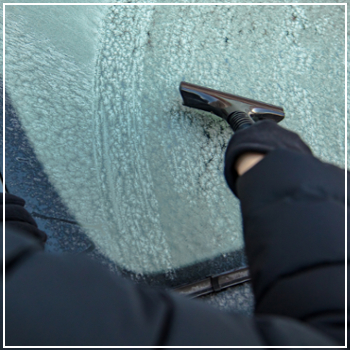 In New England, snow and icy conditions can last for several months a year. If you park your car outdoors during winter, removing the accumulation often involves brushing and scraping away sheets of frozen precipitation that has hardened to your windows.
In New England, snow and icy conditions can last for several months a year. If you park your car outdoors during winter, removing the accumulation often involves brushing and scraping away sheets of frozen precipitation that has hardened to your windows.
Even with spring around the corner, early morning frosts can make windshields icy early on in the season. In Connecticut, cars and trucks need to be free of ice and snow before they enter the roadway.
Drivers who skip this step not only face fines but can jeopardize the safety of other motorists and pedestrians.
If you’re not careful, using an ice scraper or other tools can damage your car’s surface, including the glass and paint. Before the next snowstorm, here’s what you should know.
Using Too Much Pressure
When ice gets really stuck to the vehicle surface, you may be tempted to do whatever it takes to clear it off and get going. Yet, a more forceful motion places strain on the glass and can create small chips, scratches and cracks that worsen with time.
To limit the amount of pressure applied, start your snow removal efforts by defrosting your vehicle for about 15 minutes. Then, remove as much snow as you can with a bristled or foam-end brush before you loosen any ice with a scraper. At this point, the ice has had a chance to melt and is more likely to slide off.
Avoid Metal and Non-Scraper Tools
When it comes to glass, avoid using a metal tool. While you may think these will be stronger, metal is more likely to cause damage, including chipped or cracked glass, possibly requiring windshield replacement. For this job, a plastic scraper is preferred.
An ice scraper has a specific design and purpose that other tools can’t match. Avoid using a shovel as a scraper, as even plastic ones have a hard edge that can scrape away paint or leave deep gouges.
Certain brushes, particularly a traditional broom made of straw or nylon, can also leave surface scratches on the paint. While this technique may appear gentler than an ice scraper, the bristles combined with the ice and any debris underneath can work together to produce small, fine surface scratches that become clear once the sun shines on your vehicle.
Don’t Use an Ice Scraper on the Body
The hard plastic surface can create scratches and gouges in the paint, which, combined with damp weather and salt-covered streets, can invite corrosion to form. As an alternative, wait for your car to warm up, then remove the larger pieces of snow manually or with a push brush, not directly touching the surface.
Better Habits for Snow Removal
To avoid scratching your vehicle or dealing with rust, damaged paint or cracked glass, here’s what you can do:
- Defrost your car before you start to remove any ice or snow. A minimum of 10 minutes can work in a hurry but 15 to 20 is preferred.
- Put a pair of gloves on to remove all large chunks with your hands. By this point, the sheet of ice that has built up underneath should slide right off.
- Anything you can’t remove should be pushed off with a snow broom or brush. If you use this method, make sure the brush or broom doesn’t directly touch the car’s surface. Have the brush at least a quarter inch off the surface.
- As you remove the snow, start from the top and work down to the trunk and hood. This way, you’re not repeatedly brushing snow from the same areas.
- When scraping ice from the windows, don’t go all the way to the edge, as this can damage or rip off the moldings and trim. Instead, leave a small border of ice that won’t block your view.
- If parking outdoors is your only option, consider investing in a car cover.
- To protect the paint in winter, have your vehicle fully waxed before the season begins and do periodic touchups, particularly after a storm.
If your car has experienced damage from scraping off ice and snow, DaSilva’s Auto Body can redo the paint job and assist with rust-related repairs. To set up an appointment, contact our Naugatuck shop today.




